Comentários / Perguntas (113)
![]() Irene Jerløv escreveu:
Irene Jerløv escreveu:
Jeg kan ikke få mønstret A2 i 222-32 til at passe. Jeg strikker str XL. Mønster tegningen ligner slet ikke slet ikke bluse mønstret, når jeg forstørrer det, håber at få hjælp hurtigst muligt. Mvh Irene Jerløv
06.06.2021 - 23:12DROPS Design respondeu:
Hej Irene, Det er svært at sige hvor det går galt for dig... Du følger diagram A.2-XL, starter med de 8 masker nederst i diagrammet og strikker hver pind og følger diagrammet opad. På 3.pind tager du 8 masker ud ved stjernen, hver gang du gentager diagrammet. På 5., 7. og 9. pind tager du 2 masker ind for hver gang du gentager diagrammet. På 11.pind tager du 8 masker ud igen, hver gang du kommer til stjernen og samtidigt tager du 2 masker ind i samme rapport. Vi har set mange af denne model på Ravelry. Sig til hvis det er en speciel pind i diagrammet du vil have forklaret. :)
07.06.2021 - 13:36
![]() Fjola Løvendahl Thomsen escreveu:
Fjola Løvendahl Thomsen escreveu:
Hej, jeg tror der er mange fejl i denne opskrift på blusen, både i opskrift og diagram. da jeg var færdig med mønsteret endte jeg med at have 70 m. mere end der står i opskriften????? MVH Fjola
06.06.2021 - 11:25DROPS Design respondeu:
Hej Fjola, Vi vil gerne hjælpe dig. Hvilken størrelse strikker du? Hvor er du i opskriften? Hvor mange masker skal du have ifølge opskriften?
07.06.2021 - 12:14
![]() Kari Varpe escreveu:
Kari Varpe escreveu:
Eg forstår ikkje A2 str M. Korleis skal eg følge dei ulike diagramma, rekkefølge.
05.06.2021 - 21:45DROPS Design respondeu:
Hej Kari, A.2M første og anden pind strikkes således: 3 vrang, 1 ret, 3 vrang, 1 ret (gentag disse 8 m pinden ud). 3.pind strikkes således: tag 1 m løst af, 1 ret, løft den løse over, 1vrang, 1 ret, 1 vrang, 2 ret sammen, strik 7 masker i den med stjernen (se diagramforklaringen) gentag disse 8 masker pinden ud. 4.pind: nu har du 12 masker som strikkes således: 1 ret, 1 vrang, 1 ret, 1 vrang, 8 ret, gentag disse 12 masker pinden ud. God fornøjelse!
07.06.2021 - 14:18
![]() Mervi escreveu:
Mervi escreveu:
Mihin on kadonneet pitsineuleen kaaviot A1ja A2 suomenkieliseltä sivulta? Ehdin jo yhden paidan neuloa ja aloitin toista, mutta kaarrokkeen kuvalliset ohjeet eivät näy enää?
05.06.2021 - 20:24
![]() Fjola Løvendahl Thomsen escreveu:
Fjola Løvendahl Thomsen escreveu:
Hej, jeg forstår ikke Diagrammet i denne bluse, Diagram A2. jeg syntes den virker mystisk. Håber i kan hjælpe mig MVH Fjola
04.06.2021 - 21:26DROPS Design respondeu:
Hej, Vi behøver mere information for at vi skal kunne hjælpe dig. Hvilken størrelse? Hvilken pind i A2 synes du er mystisk....?
07.06.2021 - 12:17
![]() Jopie Groenendijk escreveu:
Jopie Groenendijk escreveu:
Beschrijving LIJF "Minder zo iedere 2 cm 4-4-4-5-5 keer in totaal enz " Moet dat niet zijn iedere 3 cm? Dat komt beter uit met de lengte va het lijf
03.06.2021 - 14:14DROPS Design respondeu:
Dag Jopie,
Nee, want het is denk ik de bedoeling dat je ongeveer op taillehoogte alle minderingen hebt gedaan. Natuurlijk ben je vrij om dat aan te passen zodat de minderingen over de hoogte van het lijf verdeeld zijn.
05.06.2021 - 09:26
![]() Neuloosi escreveu:
Neuloosi escreveu:
Ohjeen kauluksen resori ei vastaa kuvassa olevaa. Ohjeessa neuvotaan neulomaan 1n1o, mutta pitäisi tehdä 1o1n, jotta jälki olisi samanlaista kuin kuvassa olevassa paidassa. Myöskään kaavat A1 ja A2 eivät näy suomenkielisellä sivulla.
01.06.2021 - 11:38
![]() Chelin escreveu:
Chelin escreveu:
There are two segments of the graph showing a dark star. As you decrease you need to increase in order not to loose any stitches. Well, in your graph only the second black star segment is showing this. The one previous is not and that is where I'm loosing so many stitches. Please update your graph.
26.05.2021 - 17:27
![]() Chelin escreveu:
Chelin escreveu:
Regarding your last reply: I understand clearly what you are saying and how you obtained the # of stitches. I Started A2 with the 280 stitches required. The problem I clearly see is that where the graph shows the dark star, you cannot reduce stitches without replacing them; only the last segment where there is a dark star is showing this. I have taken all my stitches down to the beginning of the A2 chart and increase as decrease in the sections with the black star. Graph needs fixing.
26.05.2021 - 17:24DROPS Design respondeu:
Dear Mrs Chelin, I just worked 2 repeats of this diagram in your size and it worked increasing from 10 to 14 sts. In A.2 you will decrease a total of 32 sts (4 leaves) where 8 of these decreases are compensated with yarn overs (last leaf in height, 2nd part of A.2) and increase: 3 white stars x 8 sts = 24 sts + 2 black stars x 2 sts = 10-32+8+24+4=14 sts.
27.05.2021 - 09:18
![]() Chelin escreveu:
Chelin escreveu:
In response: The A2 is showing how it is worked over 2 repeats. By the time you reach the white star, you begin the decreases in the repeat next to it. Working in a stager manner. One repeat is work, the other just knit. The diagram shows that over 2 repeats there are 14 (16) stitches, over 2 repeats not one. If you count these as just one, yeah, you will get the 300+ stitches but you end up with 10 in one repeat and 4 in the next.
25.05.2021 - 16:13DROPS Design respondeu:
Dear Mrs Chelin, each repeat in A.2 starts with 10 sts in XXL/XXXL and you repeat 28 times these 10 sts (= 280 sts), and you will alternately increase and decrease to shape the small triangles, and when you meet the black star i n the first part of diagram you will increase 2 sts (= each repeat will be now 12 sts) and then on next to last row you increase 2 sts in the 2nd part of diagram = each repeat is now 14 sts and working 28 repeats of these 14 sts will give you 392 sts. Hope this helps.
26.05.2021 - 09:31
Swing by Spring Top#swingbyspringtop |
|||||||||||||||||||||||||
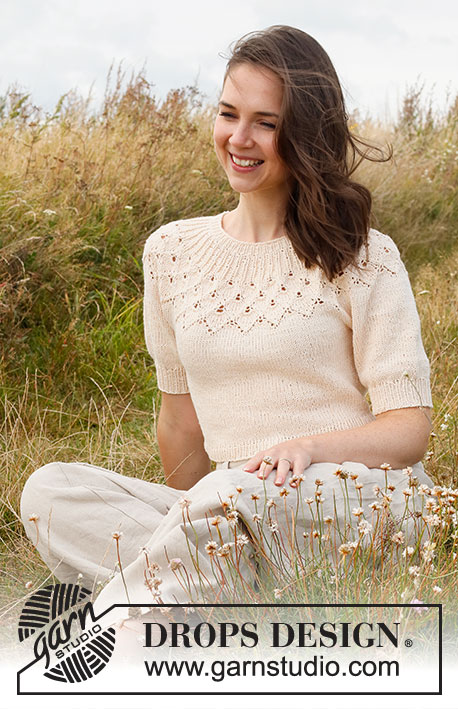 |
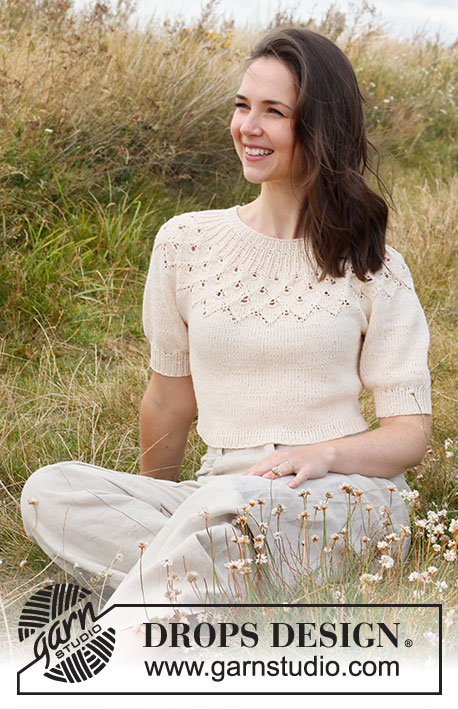 |
||||||||||||||||||||||||
Pulôver tricotado de cima para baixo com encaixe arredondado, ponto rendado, ponto de folhas e mangas balão curtas, em DROPS Belle. Do S ao XXXL
DROPS 222-32 |
|||||||||||||||||||||||||
|
------------------------------------------------------- TÉCNICAS USADAS: ------------------------------------------------------- PONTO FANTASIA: Ver os diagramas A.1 e A.2. Ver diagrama indicado para cada tamanho. DIMINUIÇÕES (lados do top): Diminuir 1 malha de cada lado do fio marcador da seguinte maneira: Tricotar até restarem 3 malhas antes do fio marcador e tricotar 2 malhas juntamente em meia, 2 malhas meia (o fio o marcador fica entre estas 2 malhas), deslizar 1 malha em meia, 1 malha meia, passar a malha deslizada por cima da malha tricotada. DICA PARA ARREMATAR: Para evitar que as malhas arrematadas fiquem demasiado apertadas, pode-se arrematar com uma agulha um tamanho acima. Se as malhas arrematadas continuarem apertadas, fazer 1 laçada depois de cerca de cada 4.ª malha e arrematar as laçadas como malhas normais. ------------------------------------------------------- A PEÇA COMEÇA AQUI: ------------------------------------------------------- PULÔVER – SUMÁRIO DA PEÇA: A gola e o encaixe tricotam-se de cima para baixo, em redondo a partir do meio das costas. Divide-se então o encaixe para as costas/a frente e as mangas. As costas/a frente tricotam-se de cima para baixo, em redondo na agulha circular. As mangas tricotam-se em redondo nas agulhas de pontas duplas/a pequena agulha circular, de cima para baixo. GOLA: Montar 100-100-104-108-112-120 malhas com a agulha circular 3 mm em Belle. Tricotar 1 volta meia. Tricotar então em canelado = 1 malha meia/1 malha liga. Quando o canelado medir 2-2-3-3-3-3 cm, continuar com a agulha circular 4 mm. Colocar 1 marcador no princípio da carreira, a meio das costas - vai-se medir o encaixe a partir deste marcador! ENCAIXE: Tricotar A.1 em redondo (= 25-25-26-27-28-30 motivos de 4 malhas). Depois de A.1, temos 200-200-208-216-280-300 malhas. A peça mede, então, 4-4-4-4-6-6 cm a partir do marcador. Tricotar então A.2 em redondo (= 25-25-26-27-28-30 motivos de 8-8-8-8-10-10 malhas). MANTER A MESMA TENSÃO DA INDICADA PARA A AMOSTRA! Depois de A.2, temos 275-300-312-351-392-420 malhas e a peça mede cerca de 14-14-14-17-19-19 cm a partir do marcador (ou seja, 16-16-17-20-22-22 cm a partir da carreira de montagem). Tricotar em ponto meia até a peça medir 18-20-21-23-25-27 cm a partir do marcador. Dividir, então, a peça para as costas/a frente e as mangas. Tricotar a carreira seguinte da seguinte maneira: Tricotar 38-42-44-50-58-63 malhas meia (= ½ costas), colocar as 62-66-68-76-80-84 malhas seguintes num alfinete de malhas para a manga, montar 8-8-12-12-12-12 malhas (= lado, sob a manga), tricotar 75-84-88-99-116-126 malhas meia (= frente), colocar as 62-66-68-76-80-84 malhas seguintes num alfinete de malhas para a manga, montar 8-8-12-12-12-12 malhas (= lado, sob a manga), tricotar as 38-42-44-50-58-63 últimas malhas em meia (= ½ costas). Terminar as costas/a frente e as mangas separadamente. MEDIR A PARTIR DAQUI! COSTAS & FRENTE: = 167-184-200-223-256-276 malhas. Colocar 1 fio marcador a meio das 8-8-12-12-12-12 novas malhas sob cada manga (= referências para os lados do top). Temos, então, 83-92-100-111-128-138 malhas para a frente e 84-92-100-112-128-138 malhas para as costas. Fazer seguir os fios marcadores à medida que for tricotando; servem para marcar as diminuições. Tricotar em redondo, em ponto meia. Quando a peça medir 3 cm a partir da separação, diminuir 1 malha de cada lado de cada fio marcador – ver DIMINUIÇÕES (= diminui-se 4 malhas). Diminuir desta maneira 4-4-4-4-5-5 vezes ao todo a cada 2 cm = 151-168-184-207-236-256 malhas. Tricotar em redondo, em ponto meia, até a peça medir 15-15-16-16-16-16 cm a partir da separação – ou até ao comprimento desejado (restam cerca de 2 cm antes ao fim). Tricotar 1 volta meia aumentando ao mesmo tempo 23-26-28-31-36-38 malhas a intervalos regulares = 174-194-212-238-272-294 malhas. Continuar com a agulha circular 3 mm em canelado (1 malha meia/1 malha liga) em redondo durante 2 cm. Arrematar as malhas como elas se apresentam – Ver DICA PARA ARREMATAR. O pulôver mede cerca de 39-41-43-45-47-49 cm de altura total a partir do ombro. MANGAS: Retomar as 62-66-68-76-80-84 malhas do alfinete de malhas de um lado da peça para as agulhas de pontas duplas/a pequena agulha circular 4 mm, e levantar 1 malha em cada uma das 8-8-12-12-12-12 novas malhas montadas no lado sob a manga = 70-74-80-88-92-96 malhas. Tricotar em redondo, em ponto meia até a manga medir 12-11-10-8-7-5 cm a partir da separação (restam cerca de 5 cm antes do fim - experimentar o pulôver e tricotar até ao comprimento desejado. Tricotar 1 volta meia diminuindo ao mesmo tempo 16-16-14-14-14-14 malhas a intervalos regulares = 54-58-66-74-78-82 malhas. Continuar com as agulhas de pontas duplas 3 mm. Tricotar em redondo, em canelado = 1 malha meia/1 malha liga durante 5 cm. Arrematar as malhas como elas se apresentam – não esquecer DICA PARA ARREMATAR! A manga mede cerca de 17-16-15-13-12-10 cm a partir da separação. Tricotar a outra manga da mesma maneira. |
|||||||||||||||||||||||||
Explicações do diagrama |
|||||||||||||||||||||||||
|
|||||||||||||||||||||||||
 |
|||||||||||||||||||||||||
 |
|||||||||||||||||||||||||
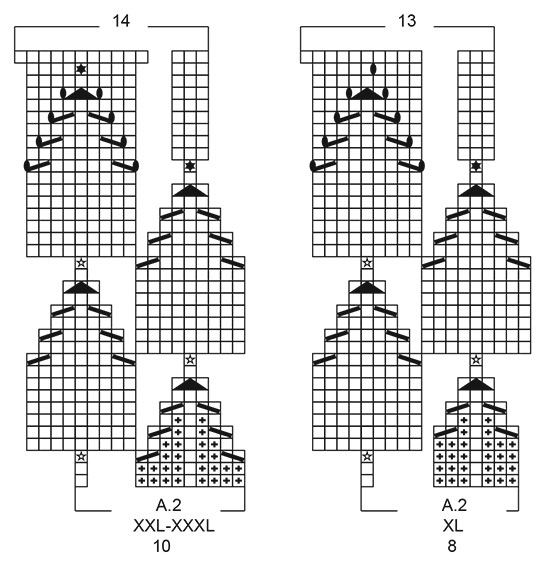 |
|||||||||||||||||||||||||
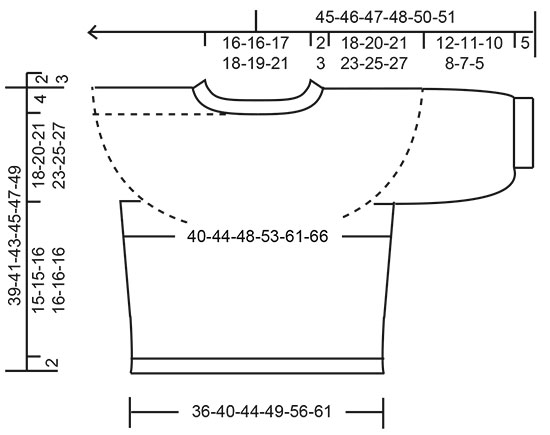 |
|||||||||||||||||||||||||
Terminou este projecto?Então, identifique as suas fotos com as tags #dropspattern #swingbyspringtop ou mostre-as na galeria #dropsfan. Precisa de ajuda para este modelo?Encontrará 30 turotiais em vídeo, uma rubrica Comentários/Perguntas e muito mais ao visitar a página do modelo em www.garnstudio.com © 1982-2025 DROPS Design A/S. Todos os direitos reservados. Este documento, incluuindo as suas su-secções, tem copyrights. Saia mais o que pode fazer com os nossos modelos no fim de cada uma das páginas do nosso site. |
|||||||||||||||||||||||||








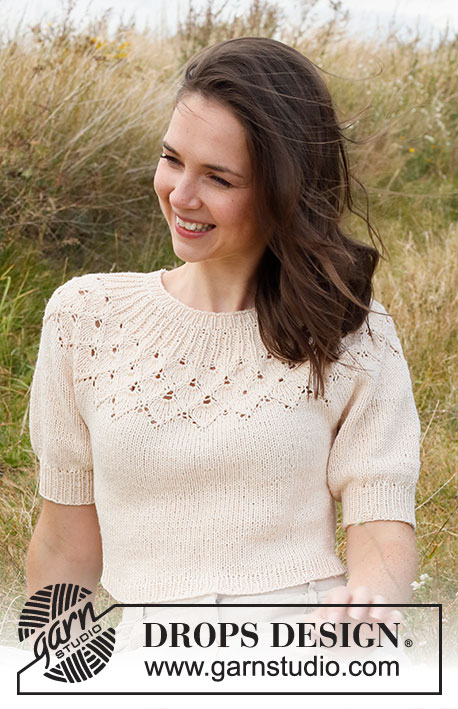
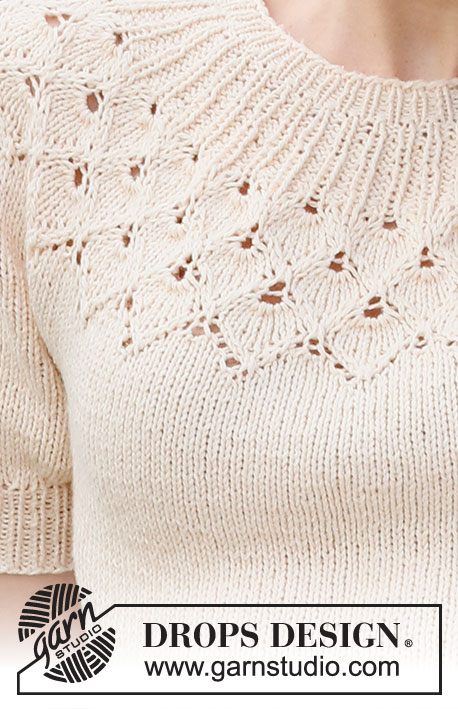



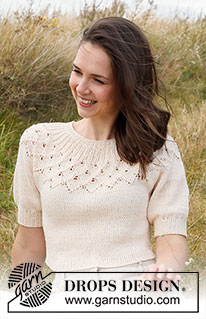
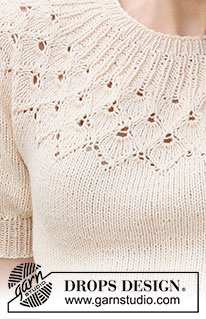







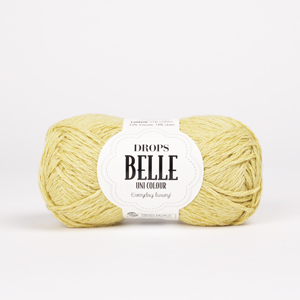









































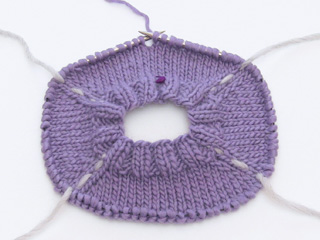














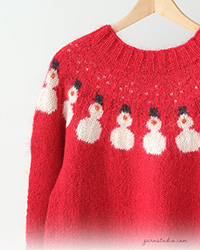





Deixe um comentário acerca do modelo DROPS 222-32
Gostaríamos muito de saber o que tem a dizer-nos acerca deste modelo!
Se deixar uma pergunta acerca do modelo, certifique-se de que escolhe a categoria adequada no formulário abaixo para acelerar o processo relativo à resposta. Os campos obrigatórios estão assinalados com um *.